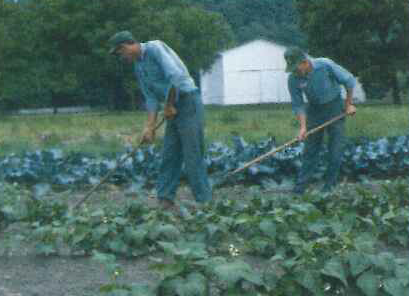The Sixties, Seventies, and Eighties
The 1960s evidenced a flurry of new activities at the Station. In 1961, the East Kentucky Resource Development Project (EKRDP) was started through a grant from the Kellogg Foundation. The program, a forerunner of much of today’s community development work, operated for 8 years in 30 counties in Appalachian Kentucky. Through the program, the current office building for the station was built in 1962 and 1963. The Quicksand Water and Sewer District was established in 1962 to provide much needed services to the Station.
Another program was initiated at the Station in the early 1960s and has had a decided impact on forestry and forest products industries in Eastern Kentucky. The Forest and Wood Technician School program, a two-year associate degree program, was initiated in 1962 and operated through 1982. The program, in cooperation with the University of Kentucky Community College system, taught more than 300 students about forestry management and processing concepts as well as the manufacturing and design of wood products. After a 13-year hiatus, the program was renewed in 1995 in cooperation with the Lee campus of Hazard Community College. Currently, 63 student are enrolled in the program.
In 1962, a bull performance test was centered at the Station. The test and sale that accompanied it were held through 1964, focusing attention on genetic improvement in beef herds in eastern Kentucky.
The Plant Materials Center was established at Robinson Substation in 1969. This cooperative effort between the Kentucky Agricultural Experiment Station and the Soil Conservation Service under terms of the Federal Appalachian Act allowed researchers to assemble, evaluate, select, and study grasses and legumes for use in soil and water conservation and the reclamation of eroded soils and strip mine lands. The Center operated at the Station through 1998.

Two acting and temporary Station superintendents (James E. Dalton and Charles Martin) followed Charles Derrickson’s departure from the post in 1965. Then George Armstrong was named Station superintendent, a position he held until his retirement in 1986. From 1972 until 1986, Armstrong also served as Quicksand Extension area director; at that time Mason Morrison, the current superintendent, was appointed. (Shirley Griffith has been secretary and staff assistant for all six of the Station’s superintendents.) The Quicksand area program director’s office was headquartered at the Station in 1969, as was an Extension agent for Expanded Foods and Nutrition programs. The Northeast area Extension program director’s office was located at the Station beginning in 1991.
Throughout the 1970s, research and Extension work continued at a steady pace. Horticulture research focused on new crops that could be used to improve farm income on small tracts. Variety testing of new types of horticulture crops continued, and disease control research for commercial vegetable crops (notably bell peppers and tomatoes) helped farmers improve yields and profits. In addition, agronomy research focused on on-farm production of feedstuffs for livestock, including hay, silage, and field corn. Field corn variety testing has been conducted at the Station since the 1940s. (The 1950 report, for example, mentioned that 30 varieties were tested; today, more than 300 varieties are tested annually.) Forestry research expanded to environmental research concerning water quality on the steep hillsides as an aftermath of timbering.
The wide use of strip mining to mine coal reserves prompted a spate of research. Research streams were, and continue to be, varied, and include reforestation of the reclaimed land, using the land for grazing cattle, raising vegetables and other crops, as well as hydrology studies to assess the effects of strip mining on water quality.
By the early 1980s, the University of Kentucky Board of Trustees conducted a review of the opportunities of raising money from the Robinson Forest through timber sales and leasing coal reserves that underlay much of the forest. The University concluded in 1982 that it should not become involved at that time in the leasing of coal reserves because of the potential adverse environmental impact.
